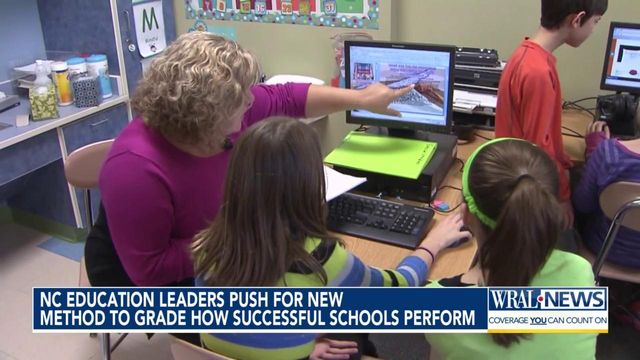NC education leaders want to change how schools are graded. Here's what that would look like
How North Carolina schools are graded is broken, State Superintendent Catherine Truitt told a legislative committee Monday.
Schools receive a letter grade every year that’s based on standardized tests scores. People can use those grades to see how well their child’s school is doing or to decide if they want to buy a home in a certain area. Schools can use those grades to determine how well they’re accomplishing their goals or whether they need to make improvements.
How the grades are calculated is set in state law. Years ago, lawmakers decide the grade would be calculated by 80% test scores and 20% test score growth. Federal education law requires every state to come up with its own grading system.
But Truitt said the system for assessing those grades is insufficient, because it doesn’t provide people with enough information about each school. She’s proposing adding more metrics to assess schools by and to make the state website with grades more user-friendly and easier for parents to understand.
“Currently, there is no meaningful accountability for low-performing schools,” Truitt said. “Currently very little is happening at the state level to support low-performing schools.”
In North Carolina, a school is low-performing if it has either a D or F grade and doesn’t show expected growth in test scores.
Lawmakers on the House Select Committee on Education Reform liked the idea of Truitt’s proposal but several had questions about unintended consequences. The committee is a specially created committee that hears about various education issues and makes recommendations on how to change education; it doesn’t meet during legislative sessions or take up bills.
Whether the school performance grades change is ultimately up to lawmakers during session, not Truitt.
Truitt said the state doesn’t have enough people working on school improvement — just five people overseeing hundreds of schools — and the state identifies too many schools as “low-performing.” North Carolina has similar or better national test scores than other Southern states that label far fewer schools as low-performing. Most states include more metrics than just test scores in their school performance grades, such as student attendance, graduation rates, school climate and other program offerings.
On Monday, Truitt proposed including several more metrics in school performance grades: career preparation, student attendance, graduation rates and educator surveys about school climate. This would help schools focus on more than just tests to help students be better prepared for life after high school, she said. Right now, hundreds of thousands of North Carolina students are “chronically absent” — missing at least 10% of school days — and keeping schools accountable to that metric could help improve it, she said. Or, holding schools accountable for career, college or military preparation might lead to more schools including programming on those things.
Each school would have four letter grades instead of just one — one for test scores, one for test score growth, one for post-high school readiness and one for opportunities for students at the school. Readiness would include things like participation in career experience activities for elementary students and career development plans for middle school students. Opportunities would include things like the percentage of students participating in extracurricular activities.
Her proposal comes from a working group of stakeholders in and out of schools, including business leaders. A group of 50 superintendents worked on the final revision Truitt proposed Monday.
But Rep. Tricia Cotham, R-Mecklenburg, a former school principal, cautioned that so many things in schools are interconnected. For example, she said, a school may have lower test scores and decide to double-down on academics. But to do that, she said, the school might have to make other cuts, like to music programs or other activities that, under Truitt’s proposal, would hurt them in the “opportunities” category.
“If your focus is math, reading and science… What do you cut? You cut the opportunity part,” Cotham said. “That’s just the reality in North Carolina.”
Michael Maher, an assistant superintendent at DPI, said the “opportunities” category is intended to encourage schools to keep those programs.
Cotham said, noting the low staffing in school turnaround, that the current accountability system was a “tremendous disservice to families and communities.”
Truitt is pushing for a bill this short session that would pilot the new school performance grades next year in schools that want to participate. Then during the 2025-26 school year, all schools would join. For the next two school years, schools would still use the current system simultaneously.
While changing the school performance grades wouldn’t cost anything, Truitt said the Department of Public Instruction needs more employees to work with the schools that need to improve student performance.
That would allow DPI staff to have better oversight of the schools, to more easily identify what needs to change at each school and to provide help.
As it stands now, she said, “If we had $1 billion from the legislature to support low-performing schools, we wouldn’t know who needs what help.”
Additionally, she said, current state law doesn’t require schools to accept help from the department.
“No one is minding the shop,” Truitt said.
Having only five people to supervise school turnaround is a concern for committee Chairman Rep. John Torbett, R-Gaston.
“Sounds like we need to readjust our priorities,” he said.












